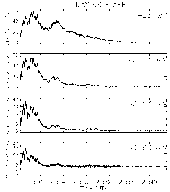
At approximately 21:17 UT on 3-may-98, active region NOAA 8210 produced an M-class flare. Yohkoh was able to observe the event successfully, and for this week's Nugget we present some pictures.
A quick way to survey the hard X-rays produced in the event is provided
by a set of light curves from HXT (below). The result here is interesting,
because the spectrum is extremely hard and the event has a long duration.
(Click on the graphs to see a larger version.)

When Flare Mode is triggered, SXT begins making images in a somewhat
different manner than in Quiet Mode. The flare images are typically at
a higher cadence (i.e., more images per minute), and also include some
lower-resolution images to show a somewhat wider field of view. The links
below will show you movies made from the half-resolution and quarter-resolution
images, which give us a chance to look for material ejected from
the flare site. The M flare of 3-may-98, the subject of these movies, threw
off some visible, "clumpy" ejecta.
| Quarter-resolution movie |
| Half-resolution movie |
Note that there is quite a lot of pixel saturation in these images. But that won't keep you from seeing the ejecta.
Finally, a look at the Half-resolution images with a different
color palette allows us to emphasize the filling of coronal loops near
the flare site. Keep your eyes on the region just to the southwest (lower-right)
of the central portion of the flare. Loop that are initially invisible
fill in and brighten to the point where the image begins to saturate.
| Loop-filling movie |